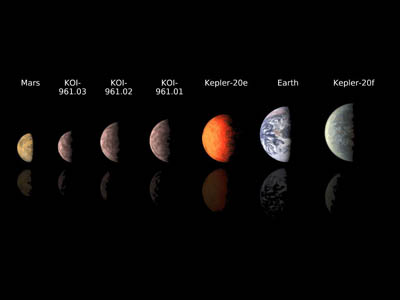Astronomers using data from NASA's Kepler mission and ground-based telescopes have confirmed that the system, called KOI-961, hosts the three smallest exoplanets known so far to orbit a star other than our sun. Photo by NASA/JPL-Caltech
NASA’s Kepler’s scientists are on a bit of a roll. Having detected what could be a future new planetary abode for humans (Kepler-22b) in early December, the Kepler team has now stumbled upon what the space agency is calling the smallest planets yet detected orbiting a star beyond our sun, otherwise known as exoplanets.
The discovery came from a team led by astronomers at California Institute of Technology (Caltech) in Pasadena.
Speaking yesterday, John Johnson, the principal investigator of the research from NASA’s Exoplanet Science Institute at Caltech, said this was the “tiniest solar system found so far”.
“It’s actually more similar to Jupiter and its moons in scale than any other planetary system. The discovery is further proof of the diversity of planetary systems in our galaxy,” said Johnson.
According to NASA, the three planets orbit a single star called KOI-961, with the trio being 0.78, 0.73 and 0.57 times the radius of Earth. Think of planet Mars and the smallest planet is comparable in size.
Kepler’s data suggests all three planets are thought to be rocky like Earth, but orbit close to their star, taking a mere two days to orbit around it.

This chart compares the smallest known exoplanets, or planets orbiting outside the solar system, to our own planets Mars and Earth. Photo by NASA/JPL-Caltech
To date, space exploration has confirmed more than 700 planets that orbit other stars (exoplanets), yet only a handful are believed to be rocky. And because the planets orbit so closely to their sun, NASA’s scientists believe that such a close orbit makes them too hot to be in the habitable zone (the region where liquid water could exist).
“Astronomers are just beginning to confirm thousands of planet candidates uncovered by Kepler so far,” said Doug Hudgins, Kepler program scientist at NASA Headquarters in Washington.
“Finding one as small as Mars is amazing, and hints that there may be a bounty of rocky planets all around us.”
The team itself in Pasadena used data publicly released by the Kepler mission, along with follow-up observations from the Palomar Observatory, near San Diego, and the W.M. Keck Observatory, which is poised atop Mauna Kea in Hawaii.
The team yesterday indicated that their measurements dramatically revised the sizes of the planets from what originally was estimated.
Planet hunters
The KOI-961 star is a red dwarf with a diameter one-sixth that of our sun, making it just 70pc bigger than Jupiter.
NASA said red dwarfs are the most common kind of star in our Milky Way galaxy. It indicated that the discovery of the three rocky planets around one red dwarf could suggest that the galaxy is “teeming” with similar rocky planets.
“These types of systems could be ubiquitous in the universe,” said Phil Muirhead, lead author of the new study from Caltech. “This is a really exciting time for planet hunters.”